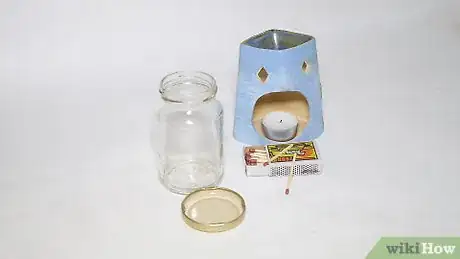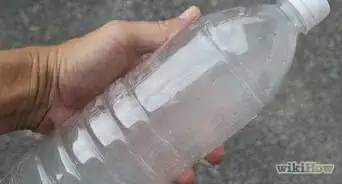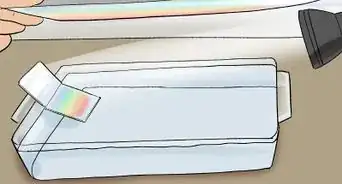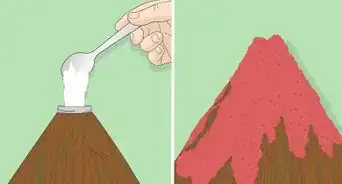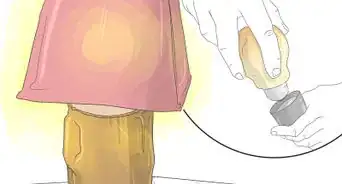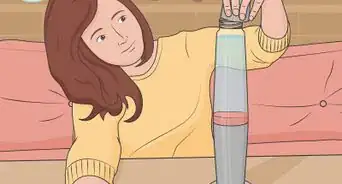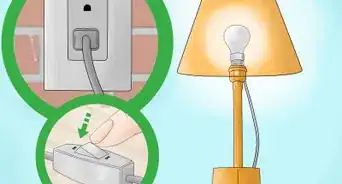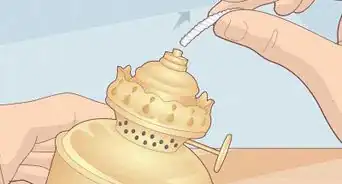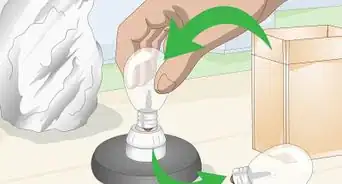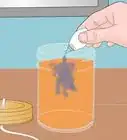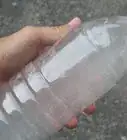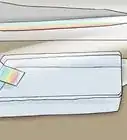wikiHow is a “wiki,” similar to Wikipedia, which means that many of our articles are co-written by multiple authors. To create this article, 149 people, some anonymous, worked to edit and improve it over time.
There are 8 references cited in this article, which can be found at the bottom of the page.
wikiHow marks an article as reader-approved once it receives enough positive feedback. This article has 15 testimonials from our readers, earning it our reader-approved status.
This article has been viewed 1,486,140 times.
Learn more...
Have you ever caught yourself being hypnotized by a lava lamp? You hold it in your hand, move it slightly, and watch as the liquid quivers and separates into different shapes and colors. Then you look at the price tag - and put it back. To do your wallet a favor and make a lava lamp with household ingredients, follow these instructions.
Steps
Making a Temporary Lava Lamp
-
1Rinse out a large soda or water bottle. Any tightly sealable container works, but you probably have an empty water bottle laying around somewhere. Try to find one that holds at least 16 ounces or 500 milliliter (16.9 fl oz), so you can clearly see the display.
- This method is safe for kids to follow on their own, and much faster and easier than making a permanent lava lamp. Young kids can ask an adult to do the pouring for them.
-
2Add oil, water, and food coloring to the bottle. Fill the bottle ¾ of the way full with vegetable oil, then top it off with water and about 10 drops of food coloring (or enough to make the solution appear fairly dark).[1]Advertisement
-
3Add salt or an Alka-Seltzer tablet to the water. If using a salt shaker, sprinkle it in for about five seconds.[2] For a more exciting, fizzing lava lamp, instead take an Alka-Seltzer tablet, break it into a few pieces, and toss them all in.
- Any other tablet labeled "effervescent" will work. These are often sold as Vitamin C tablets at drugstores.
-
4Put the cap on and tip the bottle back and forth (optional). This will cause the tiny droplets of colored water moving around inside the oil to join together, making bigger lava-squirt blobs. That's what scientists call them, anyway.
- Add more salt or another effervescent tablet whenever the blobs start moving.
-
5Place a strong flashlight or searchlight under the bottle. This will illuminate the bubbles for maximum effect. But don't leave your bottle on top of a heated surface! Plastic will melt and you'll get oil everywhere.
-
6Understand what's happening. Oil and water never mix into one fluid, instead just breaking into the strange blobs you see slipping past each other. Adding the last ingredient really stirs things up.[3] Here's why:
- Salt sinks down to the bottom of the bottle, dragging a blob of oil with it. Once the salt breaks up and dissolves in the water, the oil floats up to the top again.[4]
- The fizzy tablet reacts with the water to make tiny bubbles of carbon dioxide gas. These bubbles attach themselves to the blobs of colored water and float up to the surface. When the bubbles pop, the colored blobs sink back to the bottom of the bottle.
Making a Permanent Lava Lamp
-
1Make this lamp only with adult supervision. The alcohol and oil used in this lamp are flammable, and must be treated with care when heating them to get the lava moving. Children should show an adult these instructions and ask for help, and not attempt this on their own.
- Commercial lava lamps use a proprietary combination of melted waxes. The homemade version doesn't achieve exactly the same look, but after some tweaking your "lava" should bob up and down in similar, gooey glory.
-
2Get a glass container. You can use any clear, glass container that you can seal tightly and shake. Glass can withstand heat much better than plastic, making it a good choice for a lava lamp.
-
3Pour in a small cup of mineral oil or baby oil. This will be the "lava" bobbing up and down in your lamp. It doesn't matter how much you use, as you can always pour in more later.
- Starting with plain oil for your first attempt is a good idea, but you can mix in artist's oil paint first if you want colored "lava." Be aware that the paint might separate later, gathering on the top or bottom of the jar.
-
4Mix in 70% rubbing alcohol and 90% isopropyl alcohol.[5] Both types of alcohol are sold in drugstores. Once these are mixed in the perfect amount, the liquid will be almost the same density as the mineral oil. Here's how to achieve this:
- Mix together 6 parts 90% alcohol and 13 parts 70% alcohol.[6] (You can estimate this by filling a small cup with 90% alcohol once, then 70% alcohol twice, then pouring in an extra dash of 70%.)
- Pour this into the jar and wait for the liquid to settle. The oil should end up on the bottom, but bulge upward slightly in the center. If it looks flat, you can pour in slightly more 70% alcohol, but you don't need to get it perfect at this point.
-
5Put the jar onto a sturdy, hollow object. Screw the lid on the jar tightly before you start moving it around. Place the jar on a stable, heat-safe surface, such as a large, upside-down flower pot. This should have enough space underneath it to cover a small lamp.
-
6Add the heat source.[7] Once the oil and alcohol are very close to the same density, all you need to do is add heat beneath the lamp. Heat causes materials to expand, but causes the oil to expand slightly faster than the alcohol around it. When this happens, the oil floats to the top, cools down and shrinks, then sinks again. Let's get started:
- Select an incandescent bulb carefully. For a jar 12 ounces (350 mL) or smaller, use a 15 watt sewing machine bulb. Larger containers can use a 30 watt or 40 watt bulb, but never higher-powered ones, due to the risk of overheating or shattering the glass.
- Place this bulb in a small, directional lamp below the jar, pointing upward.
- For maximum control over the light and heat, install a dimmer switch on the lamp.
-
7Give the lamp time to warm up. Some lava lamps take a couple hours to warm up enough to start floating, but this homemade oil version usually starts moving in less time than that. Wrap your hand in a cloth and touch the jar every 15 minutes. It should get quite warm, but not searing hot. If it is too hot, turn off the lamp immediately and replace the bulb with a lower wattage.
- Try rotating the lamp gently once in a while as it warms up, using a cloth or oven mitt to touch it.
- Don't leave the lamp on when you leave the room, and turn it off to let it cool after a few hours of being on, at most.
-
8Troubleshoot if necessary. If the oil is still stuck at the bottom after a couple hours, turn it off and let it cool completely before you mess with it. Once it reaches room temperature, carefully unscrew it and try one of the following adjustments:
- Stir in a few spoonfuls of salt water to increase the density of the alcohol mixture.
- Shake the lava lamp gently to separate the oil into smaller blobs. Don't overdo this, or you'll end up with sludge instead of lava.
- If the oil has separated into tiny balls, mix in a spoonful of turpentine or other paint solvent. These are dangerous chemicals, so don't try this if the lamp is reachable by children or pets.
Community Q&A
-
QuestionCan I use coconut oil instead of vegetable oil for the temporary lava lamp?
 Community AnswerSure, coconut or olive oil would work just as well.
Community AnswerSure, coconut or olive oil would work just as well. -
QuestionCould I do it without food coloring? Would that just cause it to not have color?
 Community AnswerYes, you can make it without food coloring and it will not change the lava lamp in any way other than the color.
Community AnswerYes, you can make it without food coloring and it will not change the lava lamp in any way other than the color. -
QuestionDoes it have to be a soda or water bottle, or can it be any liquid holder?
 Community AnswerAs long as it has a lid and is perfectly sealed then you can use any bottle you want.
Community AnswerAs long as it has a lid and is perfectly sealed then you can use any bottle you want.
Warnings
- Do not heat the bottle like a normal lava lamp or allow it to become heated by holding the light underneath it for too long, especially if using plastic. Hot oil in a plastic bottle is a definite hazard.⧼thumbs_response⧽
- Do not drink the contents.[8]⧼thumbs_response⧽
Things You'll Need
Temporary Lava Lamp
- Plastic soda bottle and cap, empty and clean
- Vegetable oil (choose a cheap one)
- Food coloring
- Salt, or an Alka-Seltzer or Airborne tablet
- Water
Permanent Lava Lamp
- 70% and 90% alcohol
- Water
- Container, sealable
- Mineral oil
- Artist's oil paints (optional)
- Food coloring (optional)
- Light or heat lamp
References
- ↑ https://www.homesciencetools.com/article/how-to-make-a-homemade-lava-lamp-science-project/
- ↑ https://www.exploratorium.edu/science_explorer/volcano.html
- ↑ https://www.acs.org/content/dam/acsorg/education/outreach/kidschemistry/activities/lava-lamp.pdf
- ↑ https://www.exploratorium.edu/science_explorer/volcano.html
- ↑ https://stason.org/TULARC/science-engineering/chemistry/31-3-How-do-I-make-a-Lava-Lamp.html
- ↑ http://www.madehow.com/Volume-4/Lava-Lamp.html
- ↑ http://www.bigclive.com/lavalamp.htm
- ↑ https://www.youtube.com/watch?time_continue=5&v=QJs431FsC_k
- Videos provided by HooplaKidzLab
About This Article
To make a lava lamp with household ingredients, start by pouring vegetable oil, water, and food coloring into a plastic bottle. Then, add some salt to the bottle or an effervescent tablet so the mixture starts fizzing. Next, seal the bottle, shake it up, and place it on top of a strong flashlight, like the flashlight on your phone. Finally, watch as the bubbles inside of the bottle rise up and down. To learn how to make a permanent lava lamp using household ingredients, scroll down!

